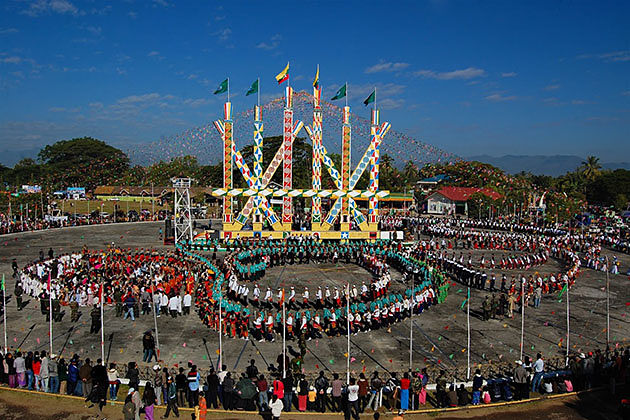
Myitkyina (Kachin State)
Kachin State has Myanmar's highest snow-capped mountain forming the southern tip of the Himalayas, and Myanmar's largest lake, Indawgyi. Kachin Hills are heavily forested group of highlands in the extreme northeastern of Myanmar, inhabited by the Kachin or Jing Paw, known on the Assam frontier as Singphos. About 50% of the total area of the Kachin land covers with hills and mountains up to the height of 5,881 m above the sea level.
Kachin land is rich in natural resources, Jades and teak-timbers are the best in quality and production of gold per unit area in the world. Jade mining is one of the lucrative businesses there and Hpa-Kant is the most popular jade mining area. The land is covered with undisturbed natural forests. The rarest natural species like Black Orchids, White Pheasants, and golden fishes in the confluence of Mali and Nmai rivers are observed.
Daily Temperature ranges from 4 - 36 C with 60 - 95% Relative Humidity. Hills cities, like Putao, have a very low temperature ranging from -4 to 18 C with low humidity. The uppermost part of Kachin land including the most beautigul Plateau-city (Putao) falls in temperate zone Annual rainfall ranges from 80 to 200 inches.
More rainfall has been observed in mountainous of the land. Estimated livings are about 6 million people including No-Kachin. Bhamo, Moekaung, Putao, Moenyin, and Katha are the major cities of the Kachin land. There are different kinds of people Kachin, Myanmar, Shan, Li Shu, Chinese, Indian and others. They are living peacefully while exercising their own religions. Buddhism, Christianity, Islam and Hinduism. There are churches, pagodas and monasteries at many places. Official government statistics states that the distribution by religion is 57% Buddhist, 36.4% Christian.
The Kachin language is the lingua franca in the state, and has a written version based on the Roman alphabet. The Kachin language is a common among Kachin, but Myanmar is the national language. The Jing Paw or Kachin people are an ethnic group who largely inhabit northern in Kachin State together with Maru(Lawngwaw), Lashi(Lachit), Zaiwa (Azi), Rawang, Lisu and five other sub-groups. These six major groups, including five other different sub-groups are together known as Kachin.
They have same traditions, customs, dialects and practices. Kachin originated from Central Asia (Ka-ang Shingra). They migrated from Central Asia via Persia, Tashkent and Sarmakand (Southern Russia), Mongolia, Huhethot, Kan Su, Tsing Hai Districts. Yalo Tsangpo of Republic of China. Then they were back to the Tsing Hai District (China and landed to the place called Chengtu (China). Then they finally migrated to the present occupied land called the Kachin land measures about 33,03 square miles. It is only about 2670 years old that the Kachin live in the present land. They were explores, and were moving along the riverbanks where they could find fertile lands. Jing Paw, also Kachin is spoken by 900,000 people in Myanmar and by 40,000 people in China. It is classified as Sino-Tibetan, Tibeto-Burman, Jingpo-Konyak_Bod, Jingpo_Lu, Jingpo proper is also understood by many speakers of Tsaiwa. One standard language that is taught in China is based on the dialect of Enkun.
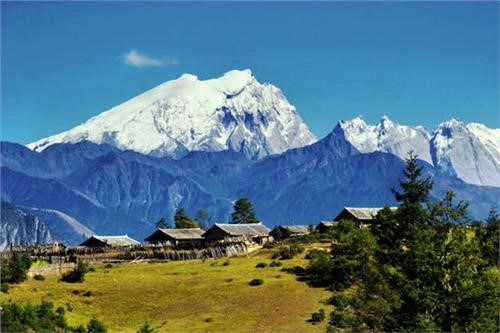
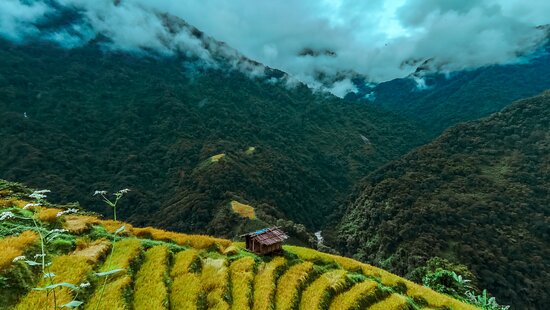
Putao (Kachin State)
Putao, the city surrounded with snow peaked mountains stretching Tibet in the northwest, is the gateway to Myanmar Himalaya. This area is famous for its Nature of originated Flor, especially there are many various kings of orchids and even the world rarest Black orchids can be found in this area. Steep fields in the valleys around are cultivated. There are gardens of hill race, maize and mixed with cereal crops, cucumber, gourds and huge marrows The higher region is populated with pin, hemlock and silver fir mixed with some larch.
From 2,750 meters to 3,660 meters almost pure conifer forests cover the slopes. There are abundance of hardwoods such as oak, maple, birch, walnut, chestnut as well as rhododendron and others. The trees such as different colors of Rhododendrons, Maple trees and various kinds of Bamboos are also seen in this area. Cold weather mist hangs over the peaceful and serene surroundings almost 6 months of the year. Flowing streams and rivulets, straw-roofed houses and fences of pebbles and creek stones provide a pleasant sight.
And for fauna, one of the rarest animal species, Takin (Budorcas Taxi color), Red Panda (Ailurus Fulgens), Black Bears, Black Deer, are all endemic to this region. Other terrestrial species of monkeys, boars, mountain goats can also be seen in this region. Various kinds of Butterflies can be seen in this area on the month of January. The Butterflies including such as an endangered species can be found, among them are Kaiser, Apollo, Bhutan, Glory and Bird-wings. January to April is the best months to see the butterflies, flowers and orchids in the icy forest.
There are also many different ethnic minority tribes in Kachin state. People or the Rawan, Lisu, Khamti-Shan, Jing paw and Kachin are represented in the region and they are simple, direct, hard working and hospitable. They make their living in the lower areas by growing paddy and fruits. The suspension bridges are the typical rier crossing in this region.
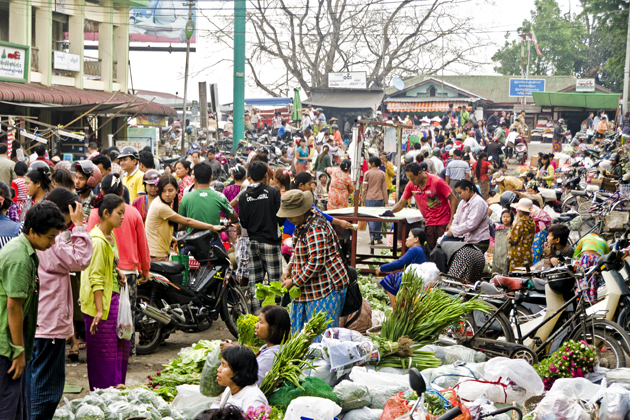
BHAMO (Bhamaw) Kachin State
Bhamo is a city in Kachin State of Myanmar, located 186 km south from the capital city of Myitkyina. It is on the Ayeyarwaddy River, and is the nearest river port to the Chinese border. The population is mix of Chinese and Shan, with Kachin peoples in the hills around the town. Bhamo was once called Sampanago, and was the capital of a now-extinct Shan Kingdom of Manmaw. The ruins of the old city walls still exist, some 5 km from the modern town.
Bhamo is a town on famous Ledo Road, connected between India, Myanmar and China. The Road is one of the most ever expensive ones in the world spending as more than US$ 137 million spent in some 1942 - 1944 constructed under the leadership of Gen Joseph W. Stilwell.
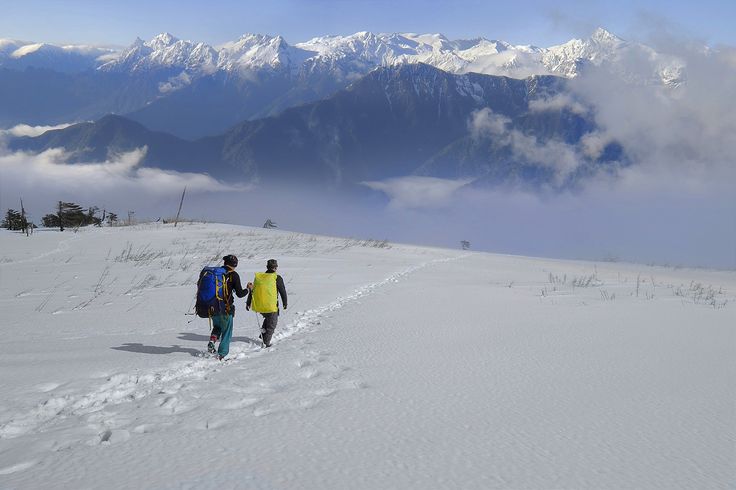
Mt. Hkakabo Razi
Mr. Hkakabo Razi, the highest peak at around 5,900 m, locates in the northern most reaches of Kachin State. It is sub range of great Himalaya mountain ranges in the eastern Himalaya region and bacame the preserved national park in 1988. The mountain stands virgin until a team of Japanese and Myanmar climber made their first ascent in 1996.
The highest peak of South East Asia and the perennially snow capped mountain with hundreds of various bio-diversities not only attracts scientists, researchers and mountaineers but also attracts trekkers and nature lovers. The remaining members of one of the endangered races. Tarong tribes, inhabited in this area are another attraction for the researchers. They are diminutive people with less than four feet in height and less average living years.
MT. PHUNGAM
Mr. Phungam, 3,485 m above sea level and situated in the Putao region, is the most suitable peak to climb among the many peaks in the region. Mt. Phungam is generally being covered with snow except August and September. Mt. Phungam is about 60 miles north-west of Putao near Myanmar-Indian border.
The remoteness and inaccessibility of the region help to maintain the pristine purity of its forest and eco-system. The richness of its biodiversity deserves to be maintained and fostered in the interest of coming generations and present unparalleled opportunities to professionals in the field of zoology, botany, forestry, environmental protection and conservation, ecology as well as hardy eco-tourists and mountaineers who prefer the challenge of an adventurous trip in the mountains of Myanmar rather than a tour of routine attractions.